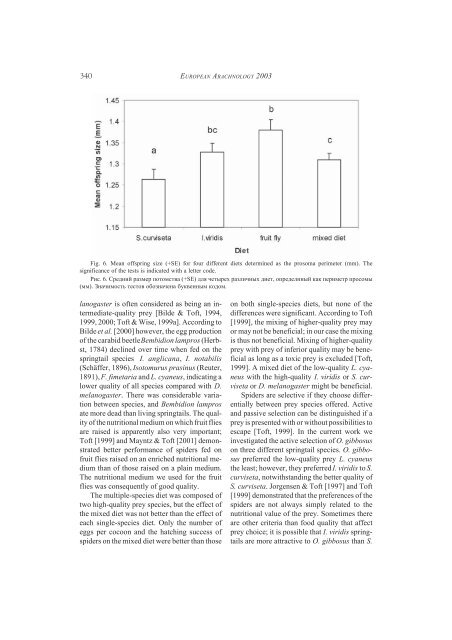The springtail Sinella curviseta - European Society of Arachnology
The springtail Sinella curviseta - European Society of Arachnology
The springtail Sinella curviseta - European Society of Arachnology
Create successful ePaper yourself
Turn your PDF publications into a flip-book with our unique Google optimized e-Paper software.
340 EUROPEAN ARACHNOLOGY 2003<br />
Fig. 6. Mean <strong>of</strong>fspring size (+SE) for four different diets determined as the prosoma perimeter (mm). <strong>The</strong><br />
significance <strong>of</strong> the tests is indicated with a letter code.<br />
Ðèñ. 6. Ñðåäíèé ðàçìåð ïîòîìñòâà (+SE) äëÿ ÷åòûðåõ ðàçëè÷íûõ äèåò, îïðåäåëííûé êàê ïåðèìåòð ïðîñîìû<br />
(ìì). Çíà÷èìîñòü òåñòîâ îáîçíà÷åíà áóêâåííûì êîäîì.<br />
lanogaster is <strong>of</strong>ten considered as being an intermediate-quality<br />
prey [Bilde & T<strong>of</strong>t, 1994,<br />
1999, 2000; T<strong>of</strong>t & Wise, 1999a]. According to<br />
Bilde et al. [2000] however, the egg production<br />
<strong>of</strong> the carabid beetle Bembidion lampros (Herbst,<br />
1784) declined over time when fed on the<br />
<strong>springtail</strong> species I. anglicana, I. notabilis<br />
(Schäffer, 1896), Isotomurus prasinus (Reuter,<br />
1891), F. fimetaria and L. cyaneus, indicating a<br />
lower quality <strong>of</strong> all species compared with D.<br />
melanogaster. <strong>The</strong>re was considerable variation<br />
between species, and Bembidion lampros<br />
ate more dead than living <strong>springtail</strong>s. <strong>The</strong> quality<br />
<strong>of</strong> the nutritional medium on which fruit flies<br />
are raised is apparently also very important;<br />
T<strong>of</strong>t [1999] and Mayntz & T<strong>of</strong>t [2001] demonstrated<br />
better performance <strong>of</strong> spiders fed on<br />
fruit flies raised on an enriched nutritional medium<br />
than <strong>of</strong> those raised on a plain medium.<br />
<strong>The</strong> nutritional medium we used for the fruit<br />
flies was consequently <strong>of</strong> good quality.<br />
<strong>The</strong> multiple-species diet was composed <strong>of</strong><br />
two high-quality prey species, but the effect <strong>of</strong><br />
the mixed diet was not better than the effect <strong>of</strong><br />
each single-species diet. Only the number <strong>of</strong><br />
eggs per cocoon and the hatching success <strong>of</strong><br />
spiders on the mixed diet were better than those<br />
on both single-species diets, but none <strong>of</strong> the<br />
differences were significant. According to T<strong>of</strong>t<br />
[1999], the mixing <strong>of</strong> higher-quality prey may<br />
or may not be beneficial; in our case the mixing<br />
is thus not beneficial. Mixing <strong>of</strong> higher-quality<br />
prey with prey <strong>of</strong> inferior quality may be beneficial<br />
as long as a toxic prey is excluded [T<strong>of</strong>t,<br />
1999]. A mixed diet <strong>of</strong> the low-quality L. cyaneus<br />
with the high-quality I. viridis or S. <strong>curviseta</strong><br />
or D. melanogaster might be beneficial.<br />
Spiders are selective if they choose differentially<br />
between prey species <strong>of</strong>fered. Active<br />
and passive selection can be distinguished if a<br />
prey is presented with or without possibilities to<br />
escape [T<strong>of</strong>t, 1999]. In the current work we<br />
investigated the active selection <strong>of</strong> O. gibbosus<br />
on three different <strong>springtail</strong> species. O. gibbosus<br />
preferred the low-quality prey L. cyaneus<br />
the least; however, they preferred I. viridis to S.<br />
<strong>curviseta</strong>, notwithstanding the better quality <strong>of</strong><br />
S. <strong>curviseta</strong>. Jorgensen & T<strong>of</strong>t [1997] and T<strong>of</strong>t<br />
[1999] demonstrated that the preferences <strong>of</strong> the<br />
spiders are not always simply related to the<br />
nutritional value <strong>of</strong> the prey. Sometimes there<br />
are other criteria than food quality that affect<br />
prey choice; it is possible that I. viridis <strong>springtail</strong>s<br />
are more attractive to O. gibbosus than S.
















